
The Atom was Acorn's first 'serious' kit machine after the System 1, and only came about because of Chris
Curry's belief in the system he'd wanted to produce whilst at Science of Cambridge. Here's a quote from him at the time, with my
additions in square brackets:
"I had to push hard for the Atom. I did the development separately with one chap [Nick Toop]. To save
money, the case for the Atom was designed not as a computer but as a keyboard for the Systems [1,2,3,4,5]. We asked the industrial
designer [Roger Wilson] to make something which was low-key, not too flashy. He produced the Atom."
RAM for the Atom was a staggering 2K, expandable to the
dizzy heights of 128K with an expansion board. Processor-wise the 6502 was chosen over the Z80 used by Sinclair because Acorn
felt it was a faster chip, contrary to popular belief at the time. The BASIC interpreter was a development of the variant used
when they were a fledgling company writing process control systems and so was built for speed, not comfort. This caused a flurry
of criticism because most of the other manufacturers were using a form of Microsoft BASIC.
Launched in 1980, the Atom was an immediate success despite the critics' misgivings about the BASIC. It was
available as either a kit for approx. £120 or fully assembled for £150 which meant both hobbyists and people new to computers could
dive straight in and start working, though if the machine was THAT popular it doesn't really explain their apparent
rarity these days, unless people just chucked 'em when they upgraded.
Several add-on kits were available for the Atom from both Acorn and 3rd parties, including a hi-res colour
board, memory boards a-plenty, ECONET, software on ROM and a keyboard to allow disabled people to use the machine.
Because my Atom came with a massive home-made PSU containing 2 of the biggest capacitors I've seen I didn't
dare plug it in 'cos I didn't want to be in the same room as them if they decided to pop :) A chance finding on eBay led me to be
fortunate enough to meet Nick Toop himself at his office, and he kindly gave the machine a full health check. Good job he did 'cos
if I'd plugged an unregulated PSU into it (eg Spectrum/ZX81) I'd have fried the internals - the previous owner had fitted a switch
internally that shorted out the regulators! Thanks Nick!
2003 Pictures
 |  |  | 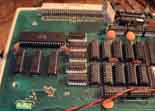 |
 | 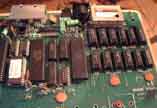 |  |  |
2025 Update
I revisited this machine for the Retro Gaming Festival weekend in November 2025. It's been sat on a shelf behind me all the while so it was about time it came
out for another run. It hadn't been tested in anger since Nick last examined it back in 2004 so this was going to be entertaining. Or so I thought. Nick had removed the Big Switch
which shorted regulator links LK6 and LK7 on the board so you could feed the machine 5V from a stable supply, so this meant I had to use an unstable supply :)
With so many 2114 RAM chips on board there was bound to be a failure after all this time, bound to be. I beeped out the power circuit to check if the DC jack
was centre positive or negative, then set my bench PSU to 8.5V 1.5A and plugged it in. Nothing. My monitor just sat there going 'what?' OK, check for thermal events in the chips, is one
of the 2114s overheating? CPU dead? As you can see from the thermal camera image it was obvious what the fault was - the left hand 7805 regulator that powers the CPU and main RAM was
dead. It could've been dead for decades if the previous owner switched them out. Fortunately I keep those in stock, so after a quick swap I bolted everything back together and...
The bench PSU hit its amp limit. I'd set it to 1.5A, so some extra reading was needed. Posts on the Stardock forums hinted that I might need up to 2A or more to
get the machine running, so I held my breath and changed the current limit to 2A. And the machine booted. And worked. And the keyboard worked!
I was almost disappointed, but this meant I could concentrate on getting a copy of Chuckie Egg running...
Resurrecting the machine also meant I could revisit the monster PSU with its monster caps - I'd love to know the other functions this PSU used to do before the
Atom came along, or perhaps they were used WITH the Atom. I need to attempt reforming the big caps in this supply before first power up though, it's not been energised for 30-40 years.
Thermal Image
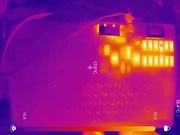 |  |  |  |
Pictures
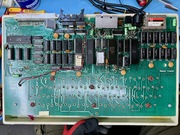 | 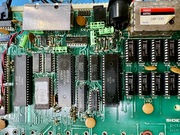 | 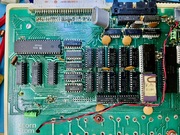 | 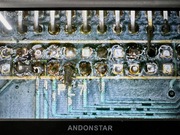 |
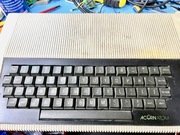 | 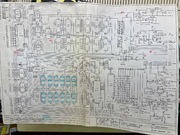 | 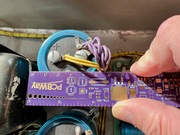 | 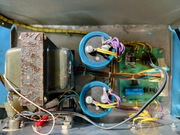 |
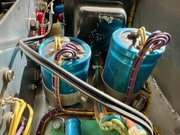 | 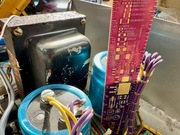 | 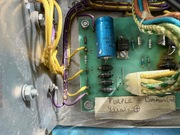 | 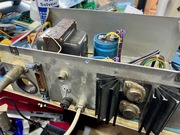 |
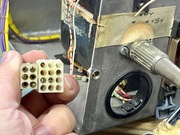 | 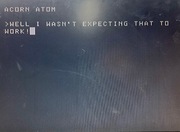 |  |  |